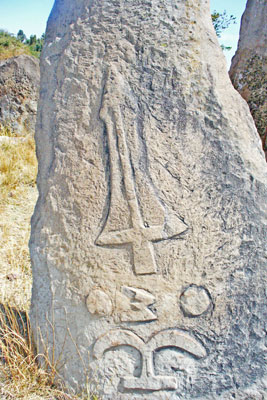Ethiopia’s enigmatic stelae at Tiya
It was my privilege to visit Tiya as part of a trip to Ethiopia with Spiekermann Travel Service (Eastpointe, MI; 800/645-3233) in January ’11. Tiya is regarded as the most important of the 160 archaeological sites in the Soddo region south of Addis Ababa.
Thirty-six huge stone monoliths, 32 of which bear strange carvings of swords and other signs and symbols, stand clustered in the tall grasses of a large field less than a kilometer outside the small town of Tiya. The stelae were designated a UNESCO World Cultural Heritage Site in 1980.
The site is enclosed in a barbed-wire fence and entered through a large metal gateway. The carvings on the stelae have, for the most part, not yet been deciphered. The largest stela rises to an impressive height of five meters (over 16 feet).
Excavations by French and Ethiopian archaeologists have unearthed stone artifacts as well as skeletons of humans who likely were between 18 and 30 years in age when they died. The stelae appear to mark mass graves that may be those of warriors. Carbon testing has dated the remains to the 12th to 14th centuries.
Who created the stelae and what their purpose might have been, aside from marking graves, is still unknown.
The most common carvings on the stelae are swords, each of which may indicate the number of people buried at the site or the number of people killed by the warrior buried there.
Some carvings appear to be schematic representations of humans. Carved circles are thought to represent female breasts; other carvings are thought to be human body parts or tools.
One of the most common motifs is the so-called “false banana tree” or “fountain-like” shape, which recalls the semicircular forms found topping the stelae at Axum.
Earlier in the trip, I saw stelae at the Ethiopian National Museum in Addis Ababa. One fragment in a dusty showcase inside the museum was poorly displayed and underlighted, but outside on the museum grounds were two masterpieces of the stone carvers’ art. These stelae were ornately carved with a plethora of swords and mysterious signs and symbols, and one is vaguely anthropomorphic in form. When visiting the museum, these should not be missed.
If you go, the half-day trip from Addis Ababa to Tiya is probably best done with a local guide, but you could go independently, as the entrance to the site is clearly identifiable from the road (one of the better highways in Ethiopia), and there is a professional, English-speaking guide, Senai Eshete, on site. Admission costs 50 birr (about $3) — plus a tip for Senai.
This visit to peaceful Tiya, with its mysterious and enigmatic stelae, was one of the highlights of my trip to Ethiopia.
DAVID J. PATTEN
Saint Petersburg, FL

